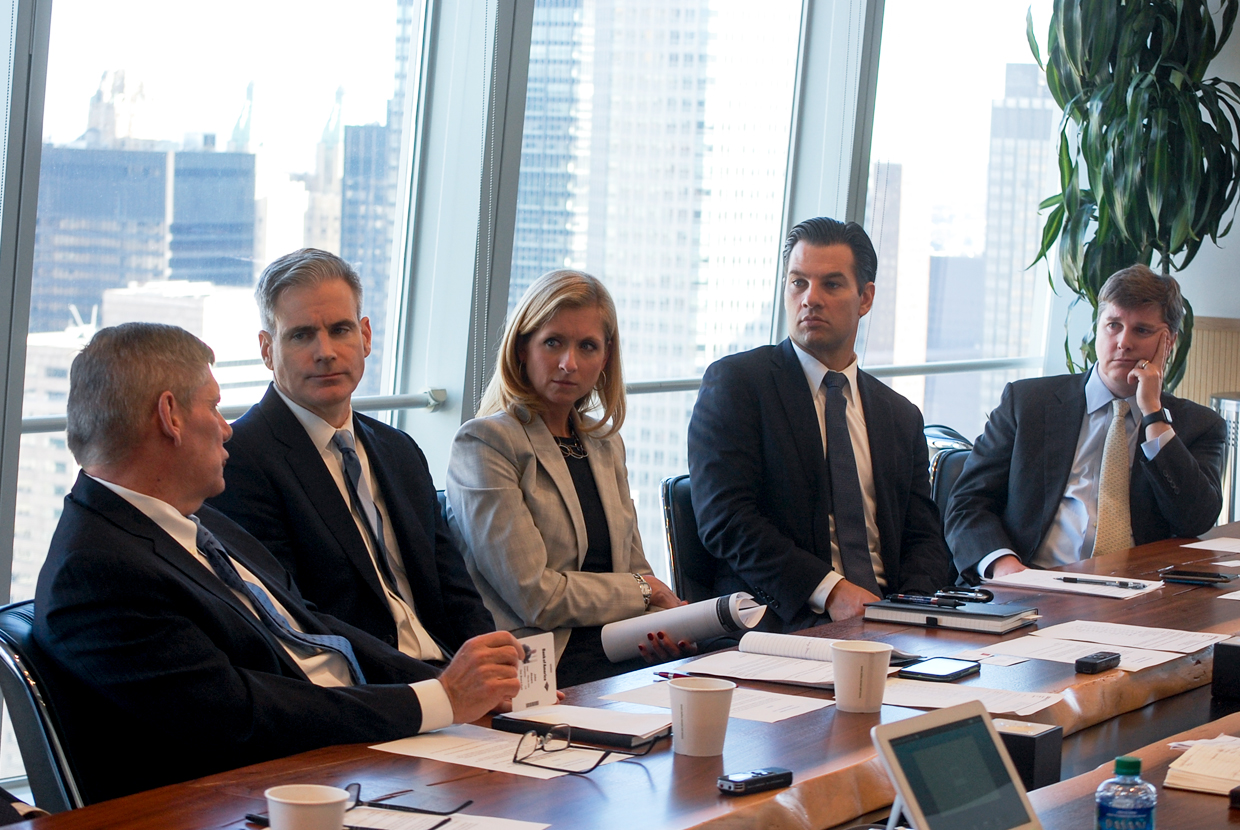GTR gathered senior trade finance bankers in New York in December to discuss the economic, technological and political trends that are reshaping the nature of their trade business in the Americas.
Roundtable participants
- John Ahearn, global head of trade, treasury and trade solutions, Citi
- Geoff Brady, head of global trade and supply chain, Bank of America Merrill Lynch (chair)
- Patricia Gomes, head of global trade and receivables finance, North America, HSBC
- Joon Kim, global head of trade product and portfolio management, treasury services, BNY Mellon
- Michael Lonie, managing director, global transaction banking department, Mizuho Bank
- Michael McDonough, head of corporate trade and supply chain, JP Morgan
- Lesley McNamara, head of global product management and strategy for trade and supply chain finance, Bank of America Merrill Lynch
- Filipe Mossmann, managing director, head of trade, Americas, transaction banking, Standard Chartered
- Rolando Perez-Elorza, managing director head of GTS Americas, BNP Paribas
- Jonathan Richman, managing director, head of US trade and working capital, Santander
- Daniel Son, senior vice-president, head of trade, Americas, Wells Fargo
Brady: Here in the US we are not used to being such a notable part of the geopolitical conversation, but that’s where we are currently. There have also been recent elections in Latin America. So the first question for the roundtable is what in your view has been the impact of changes in the world trade order on trade flows and trade financing of these flows from both a US and a Latin America perspective? Are clients changing their sourcing and selling patterns?
Richman: Speaking globally, everybody is very aware of the new risks in trade with increasing protectionism and nationalism, but it takes an awfully long time to actually change your supply chain that’s built up over years. There’s a lot of complexity. So, while we have seen a lot of clients try to diversify sourcing markets and continue to try to expand into emerging markets, they are increasingly risk aware. That has actually helped in the trade finance arena in that they are still buying from somewhere, whether it is from China or elsewhere. In terms of their selling patterns, the higher level of risk awareness, especially in emerging markets, is giving us more to sell and making our services and advice more valuable.
It is a very good time in the trade financeworld, and I don’t think that the issues we see in the headlines every day have yet had a negative impact on our business.
Mossmann: My view is similar in the sense that the risk is greater than before, especially because there is uncertainty between China and the US on trade. The two sides recently announced a truce on the introduction of new tariffs for the next 90 days, but the outcome is yet to be seen. The market needs to see where this is going to end, and in the meantime, goods will continue to be traded.
Talking specifically about the large commodity traders, we have seen small-scale shifts in flows, moving from US-Asia to Latin America-Asia – specifically Brazil – because the logistical channels are already in place. If this becomes a permanent trend, we shall see a larger shift. I agree that this makes our work more relevant, because whenever there is displacement and disruption in the supply chains, new risks come with it, and that’s exactly where we can provide structures to mitigate them. So far, it’s been more an opportunity for us to work with our clients on solutions rather than a threat of business slowdown.
Gomes: When we speak to clients, the reaction really runs the gamut. We have clients, especially the ones in industries which involve more medium-term investments, that will say, ‘do I open my next car parts plant in Michigan or Mexico?’ That kind of long-term decision-making is very difficult in the environment of uncertainty that we are living right now. It is very difficult to make long-term capex investments when you don’t really know what the end game is going to be, so you see some paralysis. And we’ve seen volumes of trade dipping a little bit from that kind of paralysis of action.
Other clients have taken the decision to source from different places – supply chains are definitely changing. Some are also looking at corporate restructuring – setting up joint ventures or entities that can access certain trade zones that are now no longer in their route of distribution or supply chain. So it really runs the gamut. I do think it’s a potential threat and a potential opportunity, depending on your situation.
For a while now we’ve seen a shift from the use of traditional trade finance risk mitigating instruments to trading on an open account basis. We are now seeing this shift slowdown, because of the uncertainty and the introduction of new trading partners that don’t yet have the same level of trust with each other.
Kim: There are plenty of opportunities in Latin America, but clients, whether FI or corporate, require a longer term, and working capital needs have become much more of a trend than in the past.
What this means is that, from the bank’s perspective, there is a little uncertainty – with the region, with the geopolitical issues. As a transaction banker or trade financier, we want to facilitate trade transactions but, with longer-term needs, there is greater concern associated with capital. So, do we have sufficient capacity to facilitate these transactions going forward? This will depend on each bank’s risk appetite.
Son: It’s very specific to which segment you belong to. We deal with a lot of the middle-market client base, and many family-owned businesses, so it’s interesting getting their perspective and views versus a company that might be more global in nature. I would agree with a lot of the comments here. There is a bit of a lag factor with what happens at the macro level versus what happens at the practical level. Many of these companies are aware from a practical perspective: the buying and selling patterns haven’t really changed much, but we are noticing potential pricing discussions the buyers and sellers are having, and again, that differs depending on the company size.
One of the biggest challenges, especially in the middle market space, is that they are only getting soundbites from the media. They are confused, because at the practical level, there is no major shift, so there is a bit of a mismatch in terms of what’s actually going on.
Lonie: When it comes to world trade we have, quite rightly, identified protectionism, jittery financial markets and existing or potential trade wars as issues impacting trade flows globally. However, what we haven’t identified is technology and what effect it’s having on trade. Indeed we are in the midst of what many are considering the fourth industrial revolution. New technologies are changing traditional trade patterns, creating new markets and products, reducing overall costs and redefining where products are sourced and who is buying them.
It remains to be seen how effective global financial institutions will be at taking advantage of these tech-driven changes. So, while there are forces at work that are negatively impacting world trade, there are also forces at work that will invariably expand world trade and make it more efficient.
Ahearn: One of the things which is not in the media conversation is the whole concept of capacity. For example, we are very active in soybeans. Today, our clients in Brazil and Argentina are selling everything they possibly can to the Chinese. Then they need soybeans for their domestic consumption, and so they buy soybeans from the US. There is also some hoarding going on. What is really interesting is that the supply chains, which became super efficient during the whole era of globalisation, aren’t that efficient anymore. What that is giving us is the opportunity to finance those inefficiencies, and it’s also very inflationary. So, the Brazilians and the Argentinians know that there is a 25% tariff for anything they buy from the US. They know that the US capacity is off the market, so now we are seeing soybean prices have gone up dramatically between Brazil, Argentina and China, because why give it to them 25% cheaper than you have to with the tariffs in place?
There just isn’t excess capacity sitting around the world waiting for this disruption. There is limited capacity, there is some overcapacity in certain markets, but in general, it’s just going to shift the trade flows. It’s not going to stop them. Even when you are talking about the EU and their sale of cars to the US. There is a whole bunch of people that will still buy a BMW even if it’s five grand more, because they want a BMW, so that is what’s really happening. And it’s the inefficiency that is going to drive our business for the next year to two years.
Brady: For those of us who attend Sibos, the star of the show is often technology, and recently the energy has been around distributed ledger or blockchain technology. However, those of us who’ve been in the business long enough know that the real story in trade finance – particularly over the last 10 years – has been around payables and receivables. That’s where we’ve seen explosive growth. The showstopper of this business is still supply chain finance (SCF): let’s talk about it. What are the trends you’re seeing in receivable discounting, securitisation, supply chain finance and inventory-related solutions?
Ahearn: It is an interesting product, because eight or nine years ago when we started this, we would have to go and do a concept sale to the client, and then we would have to do a real sale, and then we would find out how disconnected treasury was from procurement in our clients, and then we would have to go back and do another sale, and it was a very, very long run period. Today, we are getting somewhere between four to five major RFPs a quarter. That tells you that it has moved from the concept sale to the real sale.
What I am concerned about when I look at the supply chain business is that there are a variety of people doing what I would consider very, very questionable deals, and if we continue to do deals like that in the market, it will all be classified as debt. It is very important that we build standards. We need to start putting guidance around this, otherwise we are going to kill the golden goose.
In the receivables space, we are really driving our distributed finance business. We are doing pools. If you do the one-to-one receivables flows, at least for us, we cannot compete against the European banks. They have a different capital structure, and they are willing to do these things at prices that just don’t make sense from our balance sheet. So what we are doing on the receivables side is all around intellectual property. Can I inject intellectual property in that, can I help my clients get true sale off-balance sheet IFRS accounting, etcetera?
And then on inventory, there is a displacement happening right now in the market. There are huge opportunities in that space. But the problem for us, as a US bank, is we are not allowed to bring that inventory onto our balance sheet. So, we are looking for other people’s balance sheet that we can put the inventory on, and we are willing to finance it. But if I have to bring it on my balance sheet, it doesn’t work.
So, where we are really heading for, if you look at our trade business, is becoming much more of a working capital finance business in trade. We are trying to work on the three metrics: receivables, payables and inventory.
Brady: What is the number one issue in this supply chain space that you see today?
McDonough: I would echo John’s comments. The other piece is, as the product has matured, your ability to cherry-pick that select group of suppliers isn’t there. More and more buyers want to know, how are you going to get to the tail suppliers deeper in their chain? We have people coming up from the other side, be it cards, businesses, issuers, single-use accounts, MasterCard/Visa who have traditionally played in the tail but now want to move upstream. So, there is a big convergence. For us it is about efficiency.
Pricing has only gone one way in the last five to seven years. So, in a market where the pricing dynamics have changed and with the capital requirements increasing, how are you efficient? How are you going to make money?
We have all done a great job of creating a market and a business here. In some ways we are paying for it a bit and the clients want us to do more and take it deeper. For all of us it is to figure out how we can be efficient while still trying to create some economic value in having an asset that is either on balance sheet or sold into the market.
Richman: There is a strategic question here as to what is the role of a transaction bank in all of these programmes. For each bank it may be a little different, but we all face the same broad issues. You have more linkages with capital markets, and that is only going to increase, and that should hopefully deal with some of the capacity issues, but it also brings into question what our role is. Is our role going to be working capital advisory? Will we have multibank solutions? Or will fintechs manage to capture some of that? Will we be able to work with fintech to create more sophisticated models that allow us to do more events-based finance earlier in the process? Will we get more sophisticated in embedding FX conversion and other things to increase the value that we provide?
At the end of the day, we are going to have to figure out what our value-add is. Are we structurers? Originators? Onboarders? What services do we embed in this to create value? Or, are we going to let non-banks chip away at what is a growing and very attractive business?
Perez-Elorza: We have seen some banks specifically concentrating on payables and others on receivables, and even fewer players covering the full spectrum.
It really depends on the region as well. We clearly see Apac and Emea as much more advanced in terms of some of these solutions as opposed to Latin America and even the US.
It also depends on the value clients are seeing in these types of programmes. Is it just pure liquidity or is it also some type of risk management that we see, for instance, in the commodity business? Or is it also working capital optimisation and the full concept of accelerating the cash conversion?
The space is becoming much more crowded and this is putting additional pressure on pricing. With some players having different capital requirements, or compliance procedures, the playing field becomes pretty asymmetrical depending on who you talk to.
Kim: As long as we truly understand what supply chain financing is, there is plenty of appetite in the market. Let’s take an example: a number of us were at Sibos and met with our correspondent banks. Typically, what we used to talk about was that we want to buy and sell assets that are related to the corresponding banking assets. But the conversation has shifted. Correspondent banks are much more interested in buying payables and receivables of an asset for acceptable credit-graded corporates.
Not all banks are created equal, as John mentioned. BNY Mellon doesn’t typically originate a lot of supply chain financing, so how do we go about it? We use partnerships and buy some of the assets that other banks are originating, and when we calculate the return on the risk-weighted side, it comes out for us, at least internally, much better than revolver pricing, plus we earn a return on the capital of FI assets. So, if we have an opportunity to participate or originate more within this asset class, this would be an area that we certainly would focus on.
Brady: We would be remiss not to spend a bit of time on technology and digitisation. What are the challenges to commercialising the digitisation in trade and what can be done to speed up this process? Is technology a differentiator for clients? What are the issues you’re seeing?
McNamara: I spend a lot of time looking at innovation from an industry perspective. Not only because it has the potential to transform our business but because it is important to our clients. In a recent industry survey, 50% of clients said that they are more likely to award business to banks that are considered innovative. But there is a downside. If a bank promotes itself as innovative but doesn’t actually execute on those plans then about 50% say they are likely to pull business from that bank. The respondents also said that only 26% of all banks come across as innovative.
There are a number of technologies that have been or are being developed that could be transformational. Given limitations in terms of funding and/or capacity, we have to be smart and place our bets on those that are really going to move the industry.
Brady: Is there a sense that, being part of the industry foundation, our institutions have a responsibility to put down our own capital to help further the progress of digitisation, whatever we think that might be?
Gomes: The answer is absolutely yes. We at HSBC feel the obligation to respond to the changing industry and client needs, and we are. We have invested in a number of consortia to build scalable blockchain networks and we conducted the first live distributed ledger technology (DLT) letter of credit transaction in 2018. And the reality is, it’s not just about technology here. Client demands are changing, and what is being traded today is different from what was being traded, even five or 10 years ago. We are embracing the technological developments because trade needs to be simpler, faster and safer.
Lonie: As bankers we should be honest with ourselves and ask whether we are approaching DLT and blockchain technology for defensive or offensive reasons? By that I mean, are we concerned that competitors are being seen by clients to be actively involved and investing resources and capital in this technology, and therefore so should we? Or do we really believe there are economic benefits to be gained by banks and bank clients by utilising DLT and blockchain technology? And if so, have we clearly articulated what those benefits are both from a qualitative and quantitative perspective? Have cost/benefit analyses been undertaken?
While I see the merits of utilising DLT and blockchain technology to support trade transactions, I sense it will take time, perhaps years, for all relevant parties to experience the full benefits of this technology on a transactional basis. This is due to, among other things, the cost, the number of platforms and consortiums in operation at the moment and the need to integrate banks, buyers, suppliers, insurance companies, freight forwarders and so on. So I believe we have to be realistic.
On the other hand, I believe we should initially focus on using DLT and blockchain technology to streamline operational processes around compliance and risk issues. Using it in this way can significantly help reduce costs, create greater efficiencies and improve client experience.
Richman: I believe that cost coming out and improved compliance is a given. These things will happen over the next few years and be pretty dramatic. The holy grail here is how do we use the technology in a way that solves the bigger problem around credit risk models and using event-based finance. This may be a little farther out, but those who can get there actually have the secret sauce.
McDonough: There are long-term solutions. We will get to a very DLT-enabled world. There are also a lot of short-term things that we can do and clients can do today. E-bills of lading. That is fairly basic. E-invoicing. These things have been around a while so they don’t sound as sexy, but they can make a meaningful impact to our clients.
One of the messages that we like to give is to be open to looking at pilots and thinking about the future, but there are things that you can do to change your business today for the better, where you don’t have to wait for adoption or consolidation. Some of the stuff that we are doing is internal: instead of each client sending us a cover letter for the collections business, if we use a standard template, we can feed that right into our processing platform and nobody has to rekey that. That stuff doesn’t get into the headlines, but these are the little steps that make us ready for the future where we can get to digital. You can’t trade digitally unless you digitise data, and that is where some of the existing solutions can help. So we try to tell clients to be cognisant of what is out there, but here are things we can do today, and it can make an impact on your business tomorrow, not two years from now.
Ahearn: We are investing very heavily in optical character recognition (OCR), and we have gotten very far. What is really interesting about OCR is it taught us how to digitise the front office but also taught us that our back office was not ready for a digital world. We still run batch jobs. So, when the first blockchain transaction comes in and we say to them, fine, we’ll give you an answer tomorrow after our batch job runs tonight, that is not going to work out too well.
The other thing is that the industry really needs to start working on standards. One of the problems I have with all of these consortiums is that they are all building their own methodology and at some point, there is going to be a need for the consortiums to work with each other and the data to flow back and forth.
Brady: What is your main focus in the upcoming year, and what are the main challenges?
Gomes: A lot of what we are going to be focused on over the next year and a half is what we talked about here, which is trade policy and how that is impacting our clients. How can we help our clients navigate the uncertainty driven by trade policy?
If you think about how the industry is being disrupted and the impact on clients’ physical supply chains, how can we help them? We at HSBC have embarked on a process which we call ‘trade transformation’ which has a significant technological component, but it also has a component of process and people. There is going to be a huge change in what people do today in this business and what they will do in three to five years. The focus for us in 2019 is to move further along in that journey.
Mossmann: We have three key points of focus in 2019. The first is using technology to augment our capacity to manage risk, beyond traditional financial statements analysis. As an example, we are looking to apply artificial intelligence to the credit decision process for pre-shipment and buyer finance based on supply chain big data.
Secondly, on the more structured, long-term type of deals, we are focused on leading syndicated facilities. We have won a couple of mandates in 2018, and we hope to expand on this in 2019.
Lastly, we want to explore participating on mature supply chain programs that our clients already have with other banks in the US, which is not something we have done actively in the past.
McNamara: There’s been a lot of change within our organisation over the last year. As a result, 2019 will be the year to reset our strategy.
Core to that strategy will be to eliminate regional silos and operate as a truly global business. That’s really important to me as the head of product. We need to make sure that we all have the same shared priorities.
Ahearn: For us, it’s all about intellectual property. We can no longer compete in a commoditised market where we are price takers, where someone else bids 20 and we have to bid 15. So we are really driving our book toward intellectual property to our clients, because when we add intellectual property, we get paid.
Obviously, we are really looking at taking out very large amounts of our operational overhead. We have been investing heavily in OCR and artificial intelligence. We have made quantum leaps, and 2019 needs to be the year that we start getting paid back for those investments.
Perez-Elorza: We are very concerned about return on capital, so we don’t want to be price takers either. We have been building partnerships with our clients, really offering tailor-made solutions.
We have stayed away from the term ‘supply chain’, because usually supply chain is identified with payables, but the reality is that we have been much more active on receivables and inventory as well. We want to continue building the whole spectrum of working capital solutions.















